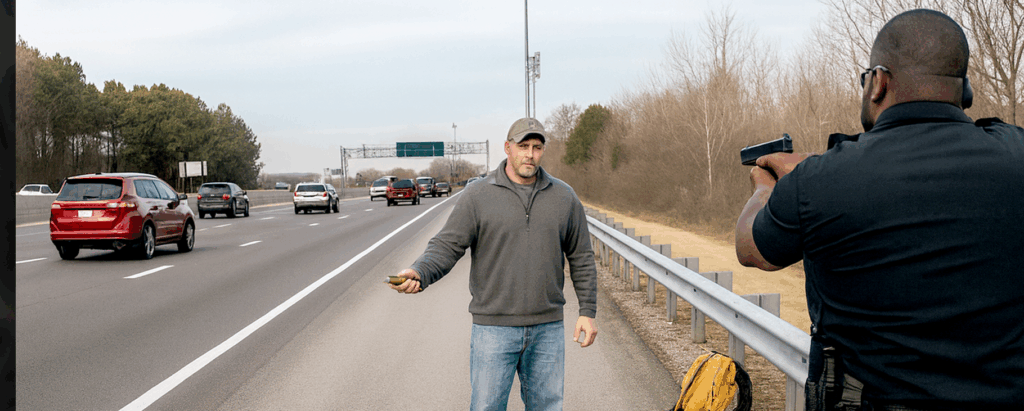Originally published on the Force Science Institute website. Republished here with permission.
How can officers, courts, and communities recognize the difference between de-escalation and “realistic” de-escalation? It starts by admitting a few realities.
First, officers have been successfully talking people out of fights and into handcuffs for generations. They are good at it. And, no matter what study is reviewed, force (even the threat of force) is used in only a small proportion of arrests.[1]
Second, unless you’re using medicine, de-escalation is not something you do “to” a person. Noncoercive de-escalation is recognizing, creating, and maintaining conditions that allow someone to regulate their own emotions.[2] Realistic de-escalation recognizes that not everybody is able or willing to de-escalate. Although de-escalation training aims to reduce the number of police shootings involving people with mental illness “behaving dangerously,” realistic de-escalation recognizes that attempts may be unreasonable precisely because of the subject’s dangerousness or mental illness.
Finally, realistic de-escalation is about accountability. It represents law enforcement’s ethical commitment to avoid force when the mission can be safely accomplished without it. But some police use of force, even deadly force, is inevitable. And when officers are called to account for their decisions, realistic de-escalation prepares them to expertly explain why it was reasonable to stop talking and force compliance.
With police reform advocates strongly supporting the use of mental health professionals in crisis training and response, it makes sense to consider exactly how these experts approach de-escalation.
This is the first article in a two-part series in which I take a close look at “realistic” de-escalation and cut through some of the myths surrounding this important police practice. Part 1focuses on lessons from emergency psychiatry and considers how the mental health profession’s de-escalation strategies benefit law enforcement. Part 2 (forthcoming) will acknowledge the unique challenges of police de-escalation and provide readers a way to analyze de-escalation and force decisions.
Lessons from Emergency Psychiatry
Although the police have been “talking people into handcuffs” for decades, there is no doubt de-escalation and communication skills continue to improve with formal collaboration between the police, academics and mental health professionals.[3] The development of Crisis Intervention Teams, Co-Responder Teams, Mobile Crisis Teams, and Case Management Teams has allowed first responders to observe the effectiveness (and limitations) of de-escalation theories in the “real-world.”
With police reform advocates strongly supporting the use of mental health professionals in crisis training and response, it makes sense to consider exactly how these experts approach de-escalation. To answer this question, I looked to the fast-paced, unpredictable world of emergency psychiatry.
Project BETA
Mental health professionals have long recognized that agitated individuals can become aggressive and violent, causing harm to themselves, others and property.[4] Not satisfied with the “restrain and medicate” approach often practiced by mental health professionals, the American Association for Emergency Psychiatry completed a project to identify the best practices in evaluation and treatment of agitation (Project BETA).[5]
Project BETA included emergency psychiatrists, emergency medicine physicians, and others associated with the emergency care of those experiencing agitation. As part of Project BETA, these professionals developed guidelines for verbal de-escalation that minimized the use of force and sedatives.[6]
The Project BETA de-escalation guidelines (Verbal De-escalation of the Agitated Patient) were specifically developed for the time-compressed, uncertain, and rapidly evolving circumstances of emergency room settings. The rationale for each of the guidelines is fully explained in the BETA report, but for convenience, the BETA authors reduced key recommendations to the following 10 “domains of de-escalation.”
- Respect personal space
- Do not be provocative
- Establish verbal contact
- Be concise
- Identify wants and feelings
- Listen closely to the patient
- Agree or agree to disagree
- Lay down the law and set clear limits
- Offer choices and optimism
- Debrief the patient and staff
Although a quick glance at the key recommendations provides some direction for effective de-escalation, officers may see obvious examples of where the guidelines may need to be refined for the “street.” Even within the mental health community, such refinements are expected.
In addition to the key recommendations, the BETA report provides critical insights for the development of law enforcement-specific de-escalation programs. Some of these insights simply validate what we recognize as important de-escalation practices (e.g., to work well with agitated people, police must be able to recognize and control their own negative reactions).
Although the police have been “talking people into handcuffs” for decades, there is no doubt de-escalation and communication skills continue to improve.
But more importantly, the BETA report provides insights that cut against many of the myths surrounding de-escalation. These insights provide law enforcement an important resource to manage the expectations of officers, courts, and communities. Here are a few insights summarized from the report:
- Some people are unable or unwilling to be engaged and verbally de-escalated.
- The goal of de-escalation is not to calm another person but to help a person calm themself.
- Verbal de-escalation is a promising practice but there is very little research on its effectiveness.
- Relying solely on a person’s report that they are not suicidal or homicidal is inadequate.[7]
- The presence of family or friends with an agitated person is not always beneficial.[8]
“Tactical” Support from Mental Health Professionals
Although Project BETA guidelines have much to offer law enforcement, the mission and operating environment may require modifications. That said, even where the BETA guidelines don’t provide an exact fit on the street, there is hidden strategic and tactical support readers will not want to miss.
Within the BETA guidelines is the strategic recommendation to design and manage physical space for safety. For mental health professionals, this means designing rooms with moveable furniture and adequate exits. It means regulating sound, wall treatment colors and temperatures to minimize stimulation. It includes the removal of objects that can be used as weapons, such as pens or other sharp objects.
Although officers don’t ordinarily choose (or design) the location of their response, they do maintain command at the scene of investigations.[9] Orders to turn down music, dim lights, manage stand-off distance, remove distracting people and contain or remove dangerous items can reduce unwanted stimulation at crisis response scenes. Such orders can appear unreasonable and arbitrary until the community recognizes the legitimate role that reducing stimulation plays in nonviolent de-escalation. The mental health professionals behind the Project BETA guidelines have validated this vital connection.
Unique Law Enforcement Purpose
Readers will undoubtedly recognize that some BETA recommendations may be difficult or simply not apply to many law enforcement situations. For example, in a clinical setting, providers are advised to always allow the agitated person an exit and to always get out of the way if the person tells you to. Even in law enforcement, there may be circumstances where those are perfectly reasonable options. Still, it’s easy to imagine situations in which a higher level of containment or control may be required for public safety.
Setting aside any differences between clinical settings and the street, one of the most important insights derived from the BETA report is one shared between the police and mental health professionals: Although skillful de-escalation can frequently reduce the need for force, some people are not willing or able to be effectively engaged or verbally de-escalated.[10] In such cases, both professions agree that the safety of the agitated person, the responder and others may require immediate physical intervention.
The question then becomes, “How do you know when?”
When to Stop Talking and Force Compliance
In Part 2 of this series on realistic de-escalation, we’ll introduce readers to the four conditions necessary for non-coercive de-escalation to remain a reasonable option. We’ll discuss how to recognize people who are not willing or able to be de-escalated and explain why it is sometimes reasonable to stop talking and force compliance.
References
- See, for example:
Garner JH, Hickman MJ, Malega RW, Maxwell CD. Progress toward national estimates of police use of force. FBI National Use of Force Collection. PLoS ONE. 2018;13(2):e0192932.Police Public Contact Survey by the Bureau of Justice Statistics as a supplement to the National Crime Victimization Survey.Alpert G, MacDonald J. Police use of force: An analysis of organizational characteristics. Justice Quarterly. 2001;18(2):393–409.Henriquez M. IACP national database project on police use of force. Use of Force by Police: Overview of National and Local Data. Washington, D.C.: Office of Justice Programs. 1999.
- International Association of Chiefs of Police. Police Use of Force in America. Arlington, VA.: 2001. The definition of de-escalation is a necessary starting point for discussions surrounding effective police practices. The author has compiled a list of 20 definitions currently being used for “de-escalation.” Available upon request.
- Those familiar with police work will recognize the irony of inviting mental health professionals out to help manage agitated and potentially violent people, since these are the very people that mental health professionals have been calling the police to manage in their clinics for years.
- Gates DM, Ross CS, McQueen L. Violence against emergency department workers. J Emerg Med. 2006; 31:331–337.
- Holloman GH, Zeller SL. Overview of Project BETA: Best practices in Evaluation and Treatment of Agitation. West J Emerg Med. 2011.
- Richmond JS, Berlin JS, Fishkind AB, et al. Verbal de-escalation of the agitated person: consensus statement of the American Association for Emergency Psychiatry Project BETA De-escalation Workgroup. West J Emerg Med. 2011.
- Stowell KR, Florence PF, Harman HJ, et al. Psychiatric Evaluation of the Agitated Patient: Consensus Statement of the American Association for Emergency Psychiatry Project BETA Psychiatric Evaluation Workgroup. West J Emerg Med. 2011.
- This is not intended as legal advice. Consult with your legal advisor for the specific authority with your jurisdiction.
- According to the United States Department of Justice’s National Crime Victimization Survey conducted from 1993 to 1999, the annual rate of nonfatal, job-related violent crime was 12.6 per 1,000 workers in all occupations. Among physicians, the rate was 16.2 per 1,000, and among nurses, 21.9 per 1,000. However, for psychiatrists and mental healthcare professionals, the rate was 68.2 per 1,000, and for mental health custodial workers, 69 per 1,000. Although non-coercive de-escalation is considered a promising practice, mental health facilities continue to rely on police, security, and trained staff as part of their staff and patient safety plans.
[strategem_author][vc_custom_heading text=”De-Escalation: When & How to Make It Work
`{`On-Demand Webinar`}`” font_container=”tag:h2|font_size:36.73|text_align:center|color:%23ffffff” use_theme_fonts=”yes”]



